HND Business: Management a Successful Business Project Report Analysis
VerifiedAdded on 2022/04/18
|24
|6606
|128
Report
AI Summary
This report analyzes the management of a successful business project, focusing on Google's workplace transformation during the COVID-19 pandemic. It explores the project lifecycle, emphasizing initiating, planning, executing, monitoring/controlling, and closing stages. The report delves into factors crucial for compiling a project management plan, including project estimating, setting up projects, scheduling tasks, and balancing priorities. Various research methods, both qualitative (interviews, focus groups, ethnography, textual analysis, case studies) and quantitative (surveys, descriptive research), are examined for their importance in project management. A detailed project management plan is presented, covering aims, objectives, deliverables, quality, risk, communication, resources, and research methods. The report includes a work breakdown structure, Gantt chart, and questionnaire, along with weekly logbooks to provide timeframes and stages for completion, culminating in a comprehensive analysis of project management strategies and their application.
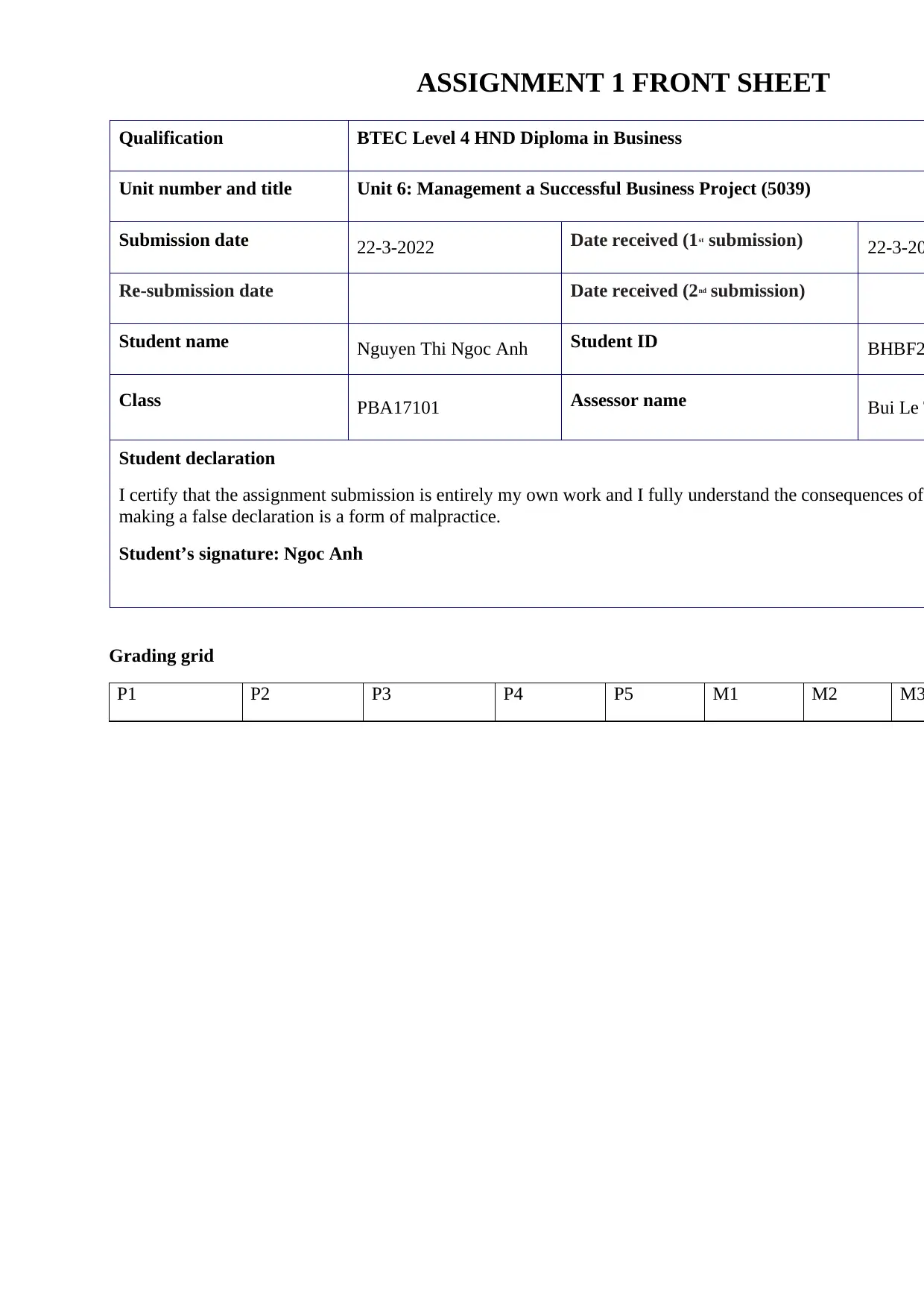
ASSIGNMENT 1 FRONT SHEET
Qualification BTEC Level 4 HND Diploma in Business
Unit number and title Unit 6: Management a Successful Business Project (5039)
Submission date 22-3-2022 Date received (1st submission) 22-3-20
Re-submission date Date received (2nd submission)
Student name Nguyen Thi Ngoc Anh Student ID BHBF2
Class PBA17101 Assessor name Bui Le T
Student declaration
I certify that the assignment submission is entirely my own work and I fully understand the consequences of
making a false declaration is a form of malpractice.
Student’s signature: Ngoc Anh
Grading grid
P1 P2 P3 P4 P5 M1 M2 M3
Qualification BTEC Level 4 HND Diploma in Business
Unit number and title Unit 6: Management a Successful Business Project (5039)
Submission date 22-3-2022 Date received (1st submission) 22-3-20
Re-submission date Date received (2nd submission)
Student name Nguyen Thi Ngoc Anh Student ID BHBF2
Class PBA17101 Assessor name Bui Le T
Student declaration
I certify that the assignment submission is entirely my own work and I fully understand the consequences of
making a false declaration is a form of malpractice.
Student’s signature: Ngoc Anh
Grading grid
P1 P2 P3 P4 P5 M1 M2 M3
Paraphrase This Document
Need a fresh take? Get an instant paraphrase of this document with our AI Paraphraser
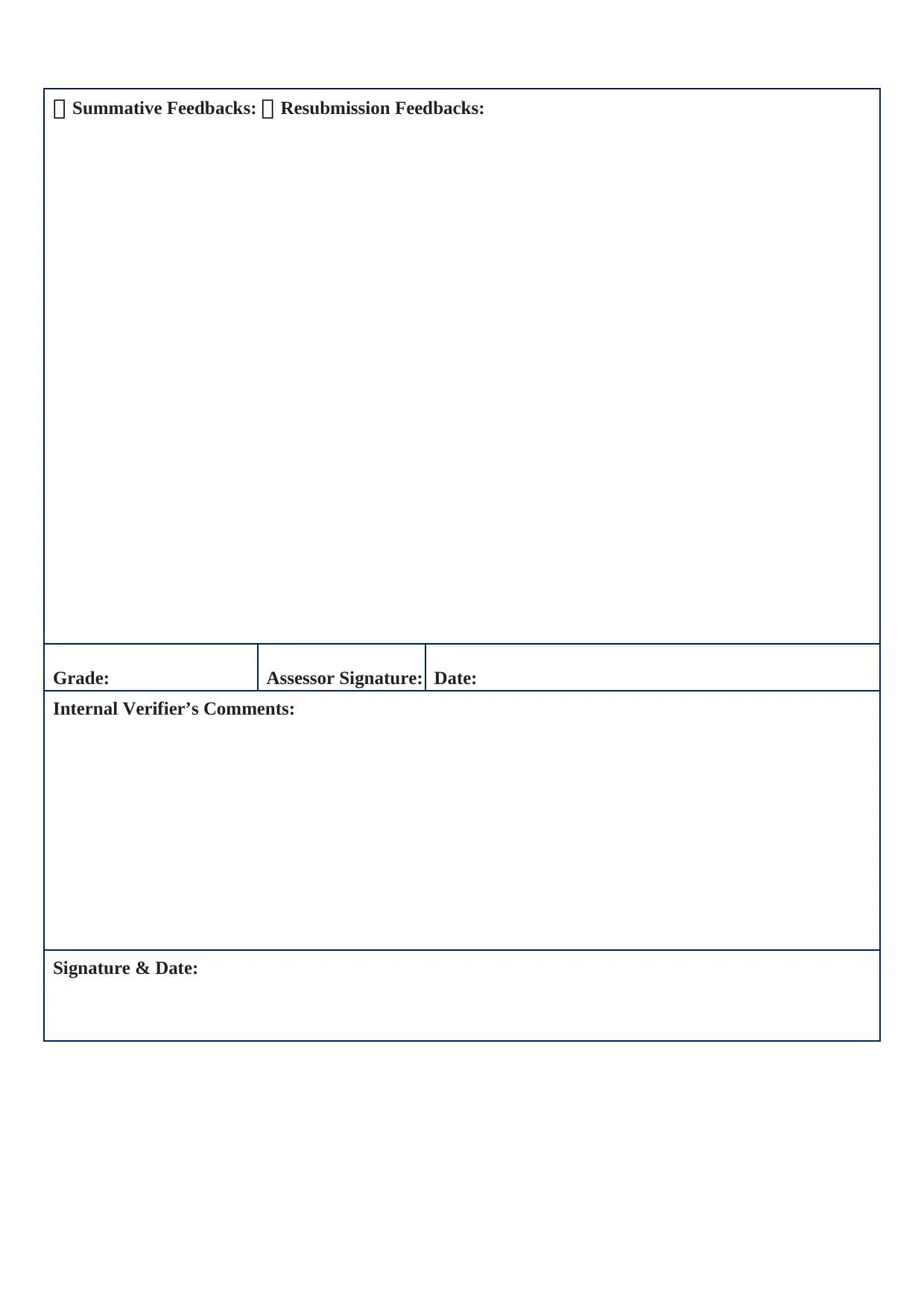
Summative Feedbacks: Resubmission Feedbacks:
Grade: Assessor Signature: Date:
Internal Verifier’s Comments:
Signature & Date:
Grade: Assessor Signature: Date:
Internal Verifier’s Comments:
Signature & Date:
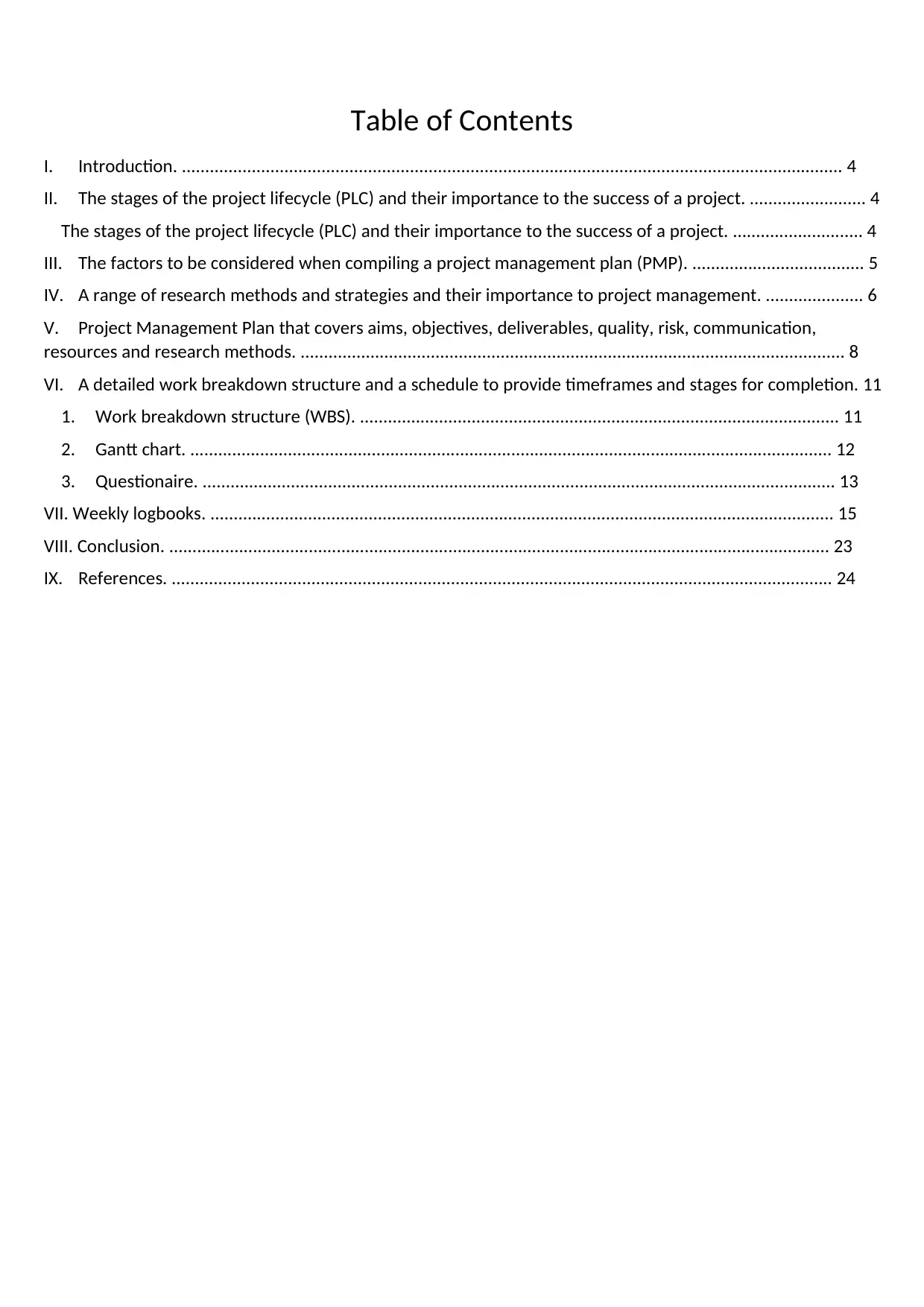
Table of Contents
I. Introduction. .............................................................................................................................................. 4
II. The stages of the project lifecycle (PLC) and their importance to the success of a project. ......................... 4
The stages of the project lifecycle (PLC) and their importance to the success of a project. ............................ 4
III. The factors to be considered when compiling a project management plan (PMP). ..................................... 5
IV. A range of research methods and strategies and their importance to project management. ..................... 6
V. Project Management Plan that covers aims, objectives, deliverables, quality, risk, communication,
resources and research methods. ..................................................................................................................... 8
VI. A detailed work breakdown structure and a schedule to provide timeframes and stages for completion. 11
1. Work breakdown structure (WBS). ....................................................................................................... 11
2. Gantt chart. .......................................................................................................................................... 12
3. Questionaire. ........................................................................................................................................ 13
VII. Weekly logbooks. ...................................................................................................................................... 15
VIII. Conclusion. .............................................................................................................................................. 23
IX. References. .............................................................................................................................................. 24
I. Introduction. .............................................................................................................................................. 4
II. The stages of the project lifecycle (PLC) and their importance to the success of a project. ......................... 4
The stages of the project lifecycle (PLC) and their importance to the success of a project. ............................ 4
III. The factors to be considered when compiling a project management plan (PMP). ..................................... 5
IV. A range of research methods and strategies and their importance to project management. ..................... 6
V. Project Management Plan that covers aims, objectives, deliverables, quality, risk, communication,
resources and research methods. ..................................................................................................................... 8
VI. A detailed work breakdown structure and a schedule to provide timeframes and stages for completion. 11
1. Work breakdown structure (WBS). ....................................................................................................... 11
2. Gantt chart. .......................................................................................................................................... 12
3. Questionaire. ........................................................................................................................................ 13
VII. Weekly logbooks. ...................................................................................................................................... 15
VIII. Conclusion. .............................................................................................................................................. 23
IX. References. .............................................................................................................................................. 24
⊘ This is a preview!⊘
Do you want full access?
Subscribe today to unlock all pages.

Trusted by 1+ million students worldwide
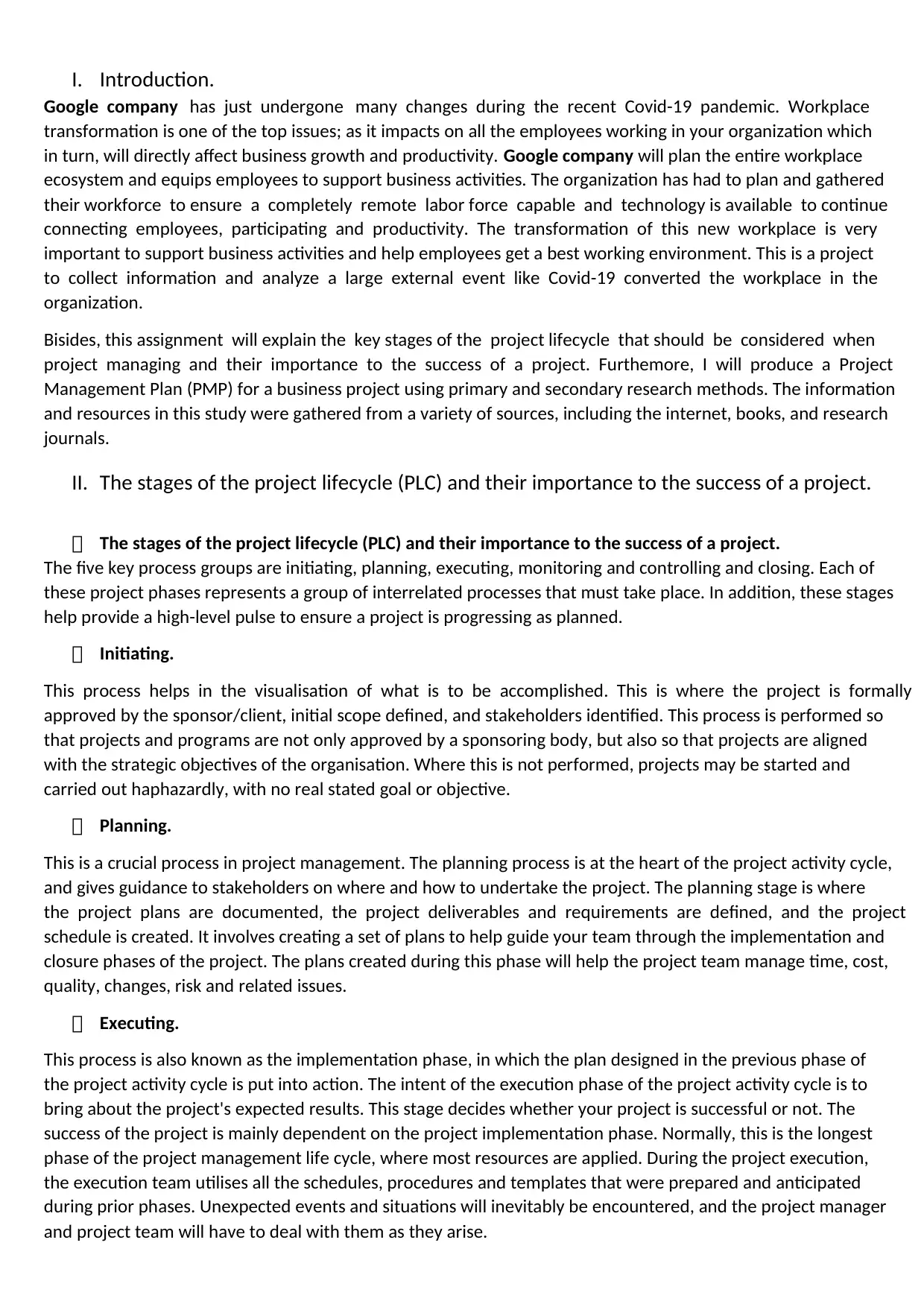
I. Introduction.
Google company has just undergone many changes during the recent Covid-19 pandemic. Workplace
transformation is one of the top issues; as it impacts on all the employees working in your organization which
in turn, will directly affect business growth and productivity. Google company will plan the entire workplace
ecosystem and equips employees to support business activities. The organization has had to plan and gathered
their workforce to ensure a completely remote labor force capable and technology is available to continue
connecting employees, participating and productivity. The transformation of this new workplace is very
important to support business activities and help employees get a best working environment. This is a project
to collect information and analyze a large external event like Covid-19 converted the workplace in the
organization.
Bisides, this assignment will explain the key stages of the project lifecycle that should be considered when
project managing and their importance to the success of a project. Furthemore, I will produce a Project
Management Plan (PMP) for a business project using primary and secondary research methods. The information
and resources in this study were gathered from a variety of sources, including the internet, books, and research
journals.
II. The stages of the project lifecycle (PLC) and their importance to the success of a project.
The stages of the project lifecycle (PLC) and their importance to the success of a project.
The five key process groups are initiating, planning, executing, monitoring and controlling and closing. Each of
these project phases represents a group of interrelated processes that must take place. In addition, these stages
help provide a high-level pulse to ensure a project is progressing as planned.
Initiating.
This process helps in the visualisation of what is to be accomplished. This is where the project is formally
approved by the sponsor/client, initial scope defined, and stakeholders identified. This process is performed so
that projects and programs are not only approved by a sponsoring body, but also so that projects are aligned
with the strategic objectives of the organisation. Where this is not performed, projects may be started and
carried out haphazardly, with no real stated goal or objective.
Planning.
This is a crucial process in project management. The planning process is at the heart of the project activity cycle,
and gives guidance to stakeholders on where and how to undertake the project. The planning stage is where
the project plans are documented, the project deliverables and requirements are defined, and the project
schedule is created. It involves creating a set of plans to help guide your team through the implementation and
closure phases of the project. The plans created during this phase will help the project team manage time, cost,
quality, changes, risk and related issues.
Executing.
This process is also known as the implementation phase, in which the plan designed in the previous phase of
the project activity cycle is put into action. The intent of the execution phase of the project activity cycle is to
bring about the project's expected results. This stage decides whether your project is successful or not. The
success of the project is mainly dependent on the project implementation phase. Normally, this is the longest
phase of the project management life cycle, where most resources are applied. During the project execution,
the execution team utilises all the schedules, procedures and templates that were prepared and anticipated
during prior phases. Unexpected events and situations will inevitably be encountered, and the project manager
and project team will have to deal with them as they arise.
Google company has just undergone many changes during the recent Covid-19 pandemic. Workplace
transformation is one of the top issues; as it impacts on all the employees working in your organization which
in turn, will directly affect business growth and productivity. Google company will plan the entire workplace
ecosystem and equips employees to support business activities. The organization has had to plan and gathered
their workforce to ensure a completely remote labor force capable and technology is available to continue
connecting employees, participating and productivity. The transformation of this new workplace is very
important to support business activities and help employees get a best working environment. This is a project
to collect information and analyze a large external event like Covid-19 converted the workplace in the
organization.
Bisides, this assignment will explain the key stages of the project lifecycle that should be considered when
project managing and their importance to the success of a project. Furthemore, I will produce a Project
Management Plan (PMP) for a business project using primary and secondary research methods. The information
and resources in this study were gathered from a variety of sources, including the internet, books, and research
journals.
II. The stages of the project lifecycle (PLC) and their importance to the success of a project.
The stages of the project lifecycle (PLC) and their importance to the success of a project.
The five key process groups are initiating, planning, executing, monitoring and controlling and closing. Each of
these project phases represents a group of interrelated processes that must take place. In addition, these stages
help provide a high-level pulse to ensure a project is progressing as planned.
Initiating.
This process helps in the visualisation of what is to be accomplished. This is where the project is formally
approved by the sponsor/client, initial scope defined, and stakeholders identified. This process is performed so
that projects and programs are not only approved by a sponsoring body, but also so that projects are aligned
with the strategic objectives of the organisation. Where this is not performed, projects may be started and
carried out haphazardly, with no real stated goal or objective.
Planning.
This is a crucial process in project management. The planning process is at the heart of the project activity cycle,
and gives guidance to stakeholders on where and how to undertake the project. The planning stage is where
the project plans are documented, the project deliverables and requirements are defined, and the project
schedule is created. It involves creating a set of plans to help guide your team through the implementation and
closure phases of the project. The plans created during this phase will help the project team manage time, cost,
quality, changes, risk and related issues.
Executing.
This process is also known as the implementation phase, in which the plan designed in the previous phase of
the project activity cycle is put into action. The intent of the execution phase of the project activity cycle is to
bring about the project's expected results. This stage decides whether your project is successful or not. The
success of the project is mainly dependent on the project implementation phase. Normally, this is the longest
phase of the project management life cycle, where most resources are applied. During the project execution,
the execution team utilises all the schedules, procedures and templates that were prepared and anticipated
during prior phases. Unexpected events and situations will inevitably be encountered, and the project manager
and project team will have to deal with them as they arise.
Paraphrase This Document
Need a fresh take? Get an instant paraphrase of this document with our AI Paraphraser
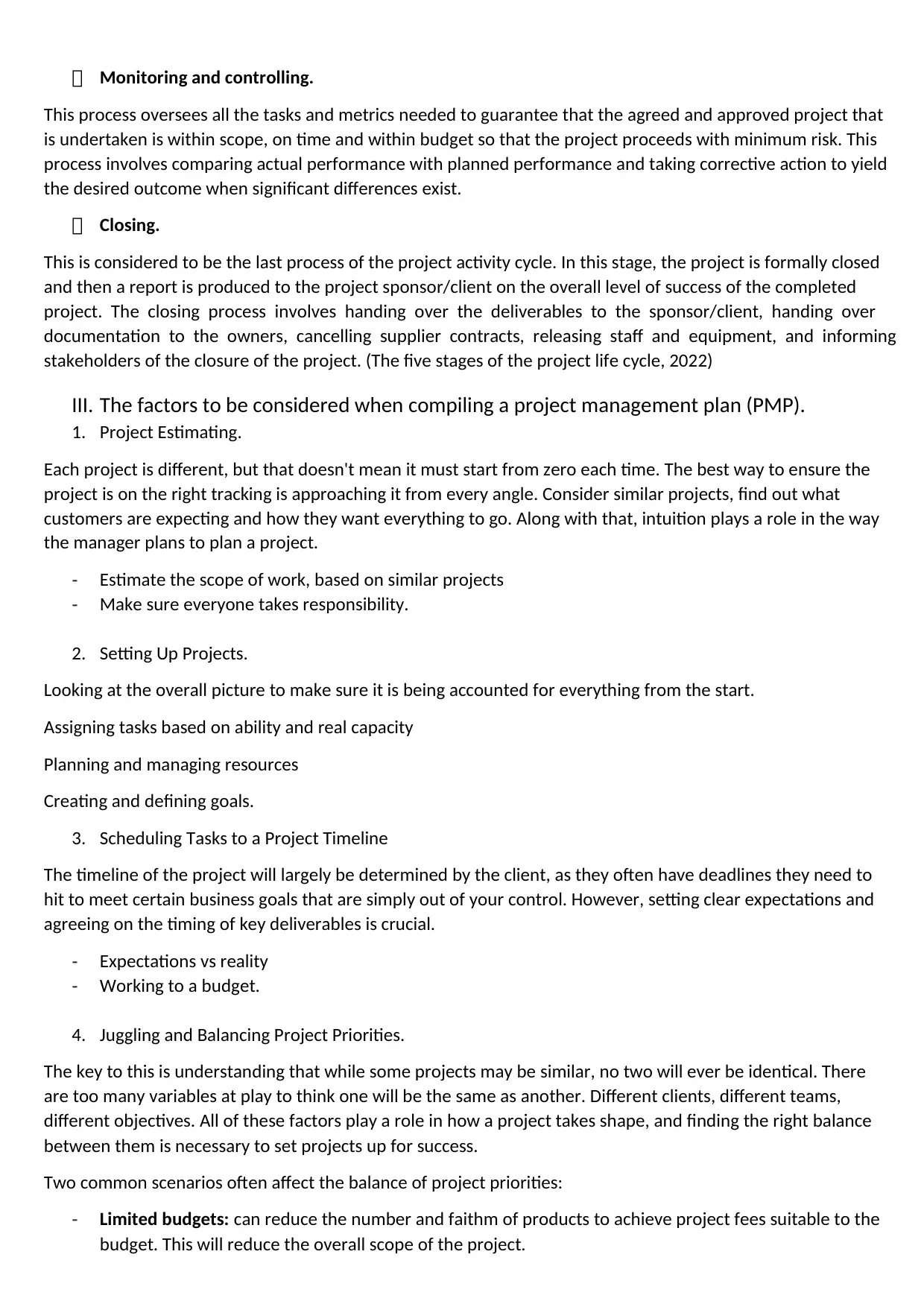
Monitoring and controlling.
This process oversees all the tasks and metrics needed to guarantee that the agreed and approved project that
is undertaken is within scope, on time and within budget so that the project proceeds with minimum risk. This
process involves comparing actual performance with planned performance and taking corrective action to yield
the desired outcome when significant differences exist.
Closing.
This is considered to be the last process of the project activity cycle. In this stage, the project is formally closed
and then a report is produced to the project sponsor/client on the overall level of success of the completed
project. The closing process involves handing over the deliverables to the sponsor/client, handing over
documentation to the owners, cancelling supplier contracts, releasing staff and equipment, and informing
stakeholders of the closure of the project. (The five stages of the project life cycle, 2022)
III. The factors to be considered when compiling a project management plan (PMP).
1. Project Estimating.
Each project is different, but that doesn't mean it must start from zero each time. The best way to ensure the
project is on the right tracking is approaching it from every angle. Consider similar projects, find out what
customers are expecting and how they want everything to go. Along with that, intuition plays a role in the way
the manager plans to plan a project.
- Estimate the scope of work, based on similar projects
- Make sure everyone takes responsibility.
2. Setting Up Projects.
Looking at the overall picture to make sure it is being accounted for everything from the start.
Assigning tasks based on ability and real capacity
Planning and managing resources
Creating and defining goals.
3. Scheduling Tasks to a Project Timeline
The timeline of the project will largely be determined by the client, as they often have deadlines they need to
hit to meet certain business goals that are simply out of your control. However, setting clear expectations and
agreeing on the timing of key deliverables is crucial.
- Expectations vs reality
- Working to a budget.
4. Juggling and Balancing Project Priorities.
The key to this is understanding that while some projects may be similar, no two will ever be identical. There
are too many variables at play to think one will be the same as another. Different clients, different teams,
different objectives. All of these factors play a role in how a project takes shape, and finding the right balance
between them is necessary to set projects up for success.
Two common scenarios often affect the balance of project priorities:
- Limited budgets: can reduce the number and faithm of products to achieve project fees suitable to the
budget. This will reduce the overall scope of the project.
This process oversees all the tasks and metrics needed to guarantee that the agreed and approved project that
is undertaken is within scope, on time and within budget so that the project proceeds with minimum risk. This
process involves comparing actual performance with planned performance and taking corrective action to yield
the desired outcome when significant differences exist.
Closing.
This is considered to be the last process of the project activity cycle. In this stage, the project is formally closed
and then a report is produced to the project sponsor/client on the overall level of success of the completed
project. The closing process involves handing over the deliverables to the sponsor/client, handing over
documentation to the owners, cancelling supplier contracts, releasing staff and equipment, and informing
stakeholders of the closure of the project. (The five stages of the project life cycle, 2022)
III. The factors to be considered when compiling a project management plan (PMP).
1. Project Estimating.
Each project is different, but that doesn't mean it must start from zero each time. The best way to ensure the
project is on the right tracking is approaching it from every angle. Consider similar projects, find out what
customers are expecting and how they want everything to go. Along with that, intuition plays a role in the way
the manager plans to plan a project.
- Estimate the scope of work, based on similar projects
- Make sure everyone takes responsibility.
2. Setting Up Projects.
Looking at the overall picture to make sure it is being accounted for everything from the start.
Assigning tasks based on ability and real capacity
Planning and managing resources
Creating and defining goals.
3. Scheduling Tasks to a Project Timeline
The timeline of the project will largely be determined by the client, as they often have deadlines they need to
hit to meet certain business goals that are simply out of your control. However, setting clear expectations and
agreeing on the timing of key deliverables is crucial.
- Expectations vs reality
- Working to a budget.
4. Juggling and Balancing Project Priorities.
The key to this is understanding that while some projects may be similar, no two will ever be identical. There
are too many variables at play to think one will be the same as another. Different clients, different teams,
different objectives. All of these factors play a role in how a project takes shape, and finding the right balance
between them is necessary to set projects up for success.
Two common scenarios often affect the balance of project priorities:
- Limited budgets: can reduce the number and faithm of products to achieve project fees suitable to the
budget. This will reduce the overall scope of the project.
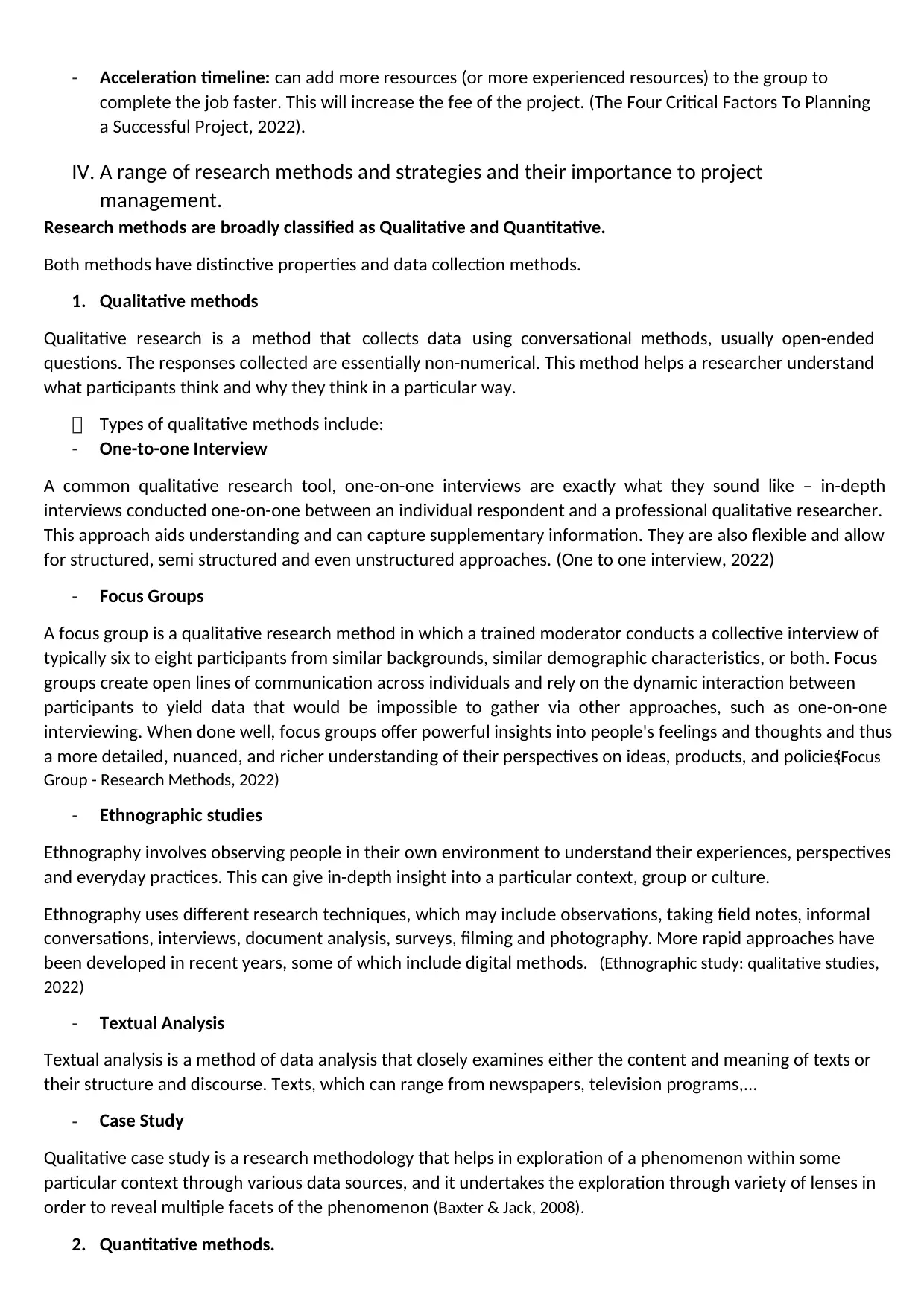
- Acceleration timeline: can add more resources (or more experienced resources) to the group to
complete the job faster. This will increase the fee of the project. (The Four Critical Factors To Planning
a Successful Project, 2022).
IV. A range of research methods and strategies and their importance to project
management.
Research methods are broadly classified as Qualitative and Quantitative.
Both methods have distinctive properties and data collection methods.
1. Qualitative methods
Qualitative research is a method that collects data using conversational methods, usually open-ended
questions. The responses collected are essentially non-numerical. This method helps a researcher understand
what participants think and why they think in a particular way.
Types of qualitative methods include:
- One-to-one Interview
A common qualitative research tool, one-on-one interviews are exactly what they sound like – in-depth
interviews conducted one-on-one between an individual respondent and a professional qualitative researcher.
This approach aids understanding and can capture supplementary information. They are also flexible and allow
for structured, semi structured and even unstructured approaches. (One to one interview, 2022)
- Focus Groups
A focus group is a qualitative research method in which a trained moderator conducts a collective interview of
typically six to eight participants from similar backgrounds, similar demographic characteristics, or both. Focus
groups create open lines of communication across individuals and rely on the dynamic interaction between
participants to yield data that would be impossible to gather via other approaches, such as one-on-one
interviewing. When done well, focus groups offer powerful insights into people's feelings and thoughts and thus
a more detailed, nuanced, and richer understanding of their perspectives on ideas, products, and policies.(Focus
Group - Research Methods, 2022)
- Ethnographic studies
Ethnography involves observing people in their own environment to understand their experiences, perspectives
and everyday practices. This can give in-depth insight into a particular context, group or culture.
Ethnography uses different research techniques, which may include observations, taking field notes, informal
conversations, interviews, document analysis, surveys, filming and photography. More rapid approaches have
been developed in recent years, some of which include digital methods. (Ethnographic study: qualitative studies,
2022)
- Textual Analysis
Textual analysis is a method of data analysis that closely examines either the content and meaning of texts or
their structure and discourse. Texts, which can range from newspapers, television programs,...
- Case Study
Qualitative case study is a research methodology that helps in exploration of a phenomenon within some
particular context through various data sources, and it undertakes the exploration through variety of lenses in
order to reveal multiple facets of the phenomenon (Baxter & Jack, 2008).
2. Quantitative methods.
complete the job faster. This will increase the fee of the project. (The Four Critical Factors To Planning
a Successful Project, 2022).
IV. A range of research methods and strategies and their importance to project
management.
Research methods are broadly classified as Qualitative and Quantitative.
Both methods have distinctive properties and data collection methods.
1. Qualitative methods
Qualitative research is a method that collects data using conversational methods, usually open-ended
questions. The responses collected are essentially non-numerical. This method helps a researcher understand
what participants think and why they think in a particular way.
Types of qualitative methods include:
- One-to-one Interview
A common qualitative research tool, one-on-one interviews are exactly what they sound like – in-depth
interviews conducted one-on-one between an individual respondent and a professional qualitative researcher.
This approach aids understanding and can capture supplementary information. They are also flexible and allow
for structured, semi structured and even unstructured approaches. (One to one interview, 2022)
- Focus Groups
A focus group is a qualitative research method in which a trained moderator conducts a collective interview of
typically six to eight participants from similar backgrounds, similar demographic characteristics, or both. Focus
groups create open lines of communication across individuals and rely on the dynamic interaction between
participants to yield data that would be impossible to gather via other approaches, such as one-on-one
interviewing. When done well, focus groups offer powerful insights into people's feelings and thoughts and thus
a more detailed, nuanced, and richer understanding of their perspectives on ideas, products, and policies.(Focus
Group - Research Methods, 2022)
- Ethnographic studies
Ethnography involves observing people in their own environment to understand their experiences, perspectives
and everyday practices. This can give in-depth insight into a particular context, group or culture.
Ethnography uses different research techniques, which may include observations, taking field notes, informal
conversations, interviews, document analysis, surveys, filming and photography. More rapid approaches have
been developed in recent years, some of which include digital methods. (Ethnographic study: qualitative studies,
2022)
- Textual Analysis
Textual analysis is a method of data analysis that closely examines either the content and meaning of texts or
their structure and discourse. Texts, which can range from newspapers, television programs,...
- Case Study
Qualitative case study is a research methodology that helps in exploration of a phenomenon within some
particular context through various data sources, and it undertakes the exploration through variety of lenses in
order to reveal multiple facets of the phenomenon (Baxter & Jack, 2008).
2. Quantitative methods.
⊘ This is a preview!⊘
Do you want full access?
Subscribe today to unlock all pages.

Trusted by 1+ million students worldwide
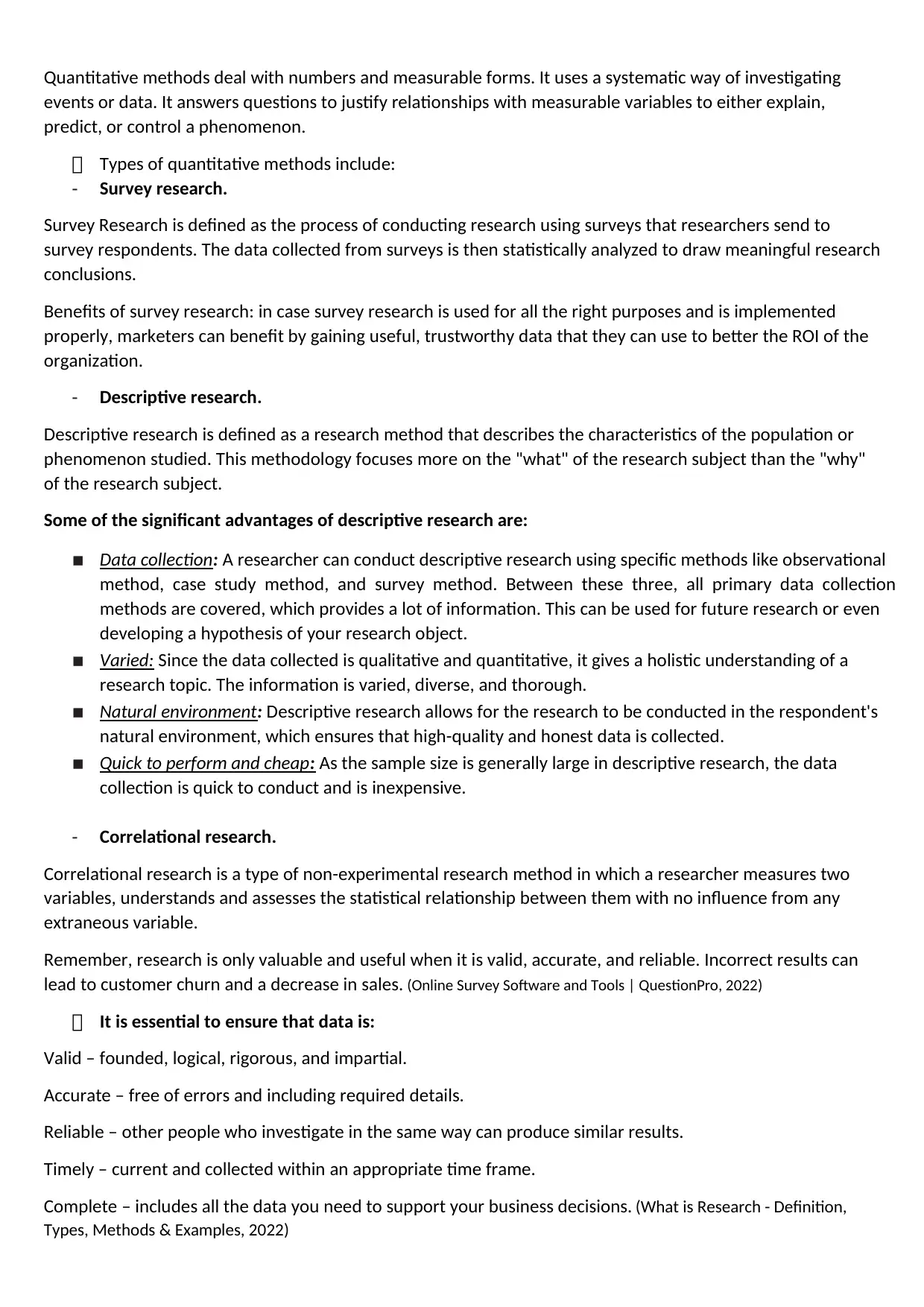
Quantitative methods deal with numbers and measurable forms. It uses a systematic way of investigating
events or data. It answers questions to justify relationships with measurable variables to either explain,
predict, or control a phenomenon.
Types of quantitative methods include:
- Survey research.
Survey Research is defined as the process of conducting research using surveys that researchers send to
survey respondents. The data collected from surveys is then statistically analyzed to draw meaningful research
conclusions.
Benefits of survey research: in case survey research is used for all the right purposes and is implemented
properly, marketers can benefit by gaining useful, trustworthy data that they can use to better the ROI of the
organization.
- Descriptive research.
Descriptive research is defined as a research method that describes the characteristics of the population or
phenomenon studied. This methodology focuses more on the "what" of the research subject than the "why"
of the research subject.
Some of the significant advantages of descriptive research are:
▪ Data collection: A researcher can conduct descriptive research using specific methods like observational
method, case study method, and survey method. Between these three, all primary data collection
methods are covered, which provides a lot of information. This can be used for future research or even
developing a hypothesis of your research object.
▪ Varied: Since the data collected is qualitative and quantitative, it gives a holistic understanding of a
research topic. The information is varied, diverse, and thorough.
▪ Natural environment: Descriptive research allows for the research to be conducted in the respondent's
natural environment, which ensures that high-quality and honest data is collected.
▪ Quick to perform and cheap: As the sample size is generally large in descriptive research, the data
collection is quick to conduct and is inexpensive.
- Correlational research.
Correlational research is a type of non-experimental research method in which a researcher measures two
variables, understands and assesses the statistical relationship between them with no influence from any
extraneous variable.
Remember, research is only valuable and useful when it is valid, accurate, and reliable. Incorrect results can
lead to customer churn and a decrease in sales. (Online Survey Software and Tools | QuestionPro, 2022)
It is essential to ensure that data is:
Valid – founded, logical, rigorous, and impartial.
Accurate – free of errors and including required details.
Reliable – other people who investigate in the same way can produce similar results.
Timely – current and collected within an appropriate time frame.
Complete – includes all the data you need to support your business decisions. (What is Research - Definition,
Types, Methods & Examples, 2022)
events or data. It answers questions to justify relationships with measurable variables to either explain,
predict, or control a phenomenon.
Types of quantitative methods include:
- Survey research.
Survey Research is defined as the process of conducting research using surveys that researchers send to
survey respondents. The data collected from surveys is then statistically analyzed to draw meaningful research
conclusions.
Benefits of survey research: in case survey research is used for all the right purposes and is implemented
properly, marketers can benefit by gaining useful, trustworthy data that they can use to better the ROI of the
organization.
- Descriptive research.
Descriptive research is defined as a research method that describes the characteristics of the population or
phenomenon studied. This methodology focuses more on the "what" of the research subject than the "why"
of the research subject.
Some of the significant advantages of descriptive research are:
▪ Data collection: A researcher can conduct descriptive research using specific methods like observational
method, case study method, and survey method. Between these three, all primary data collection
methods are covered, which provides a lot of information. This can be used for future research or even
developing a hypothesis of your research object.
▪ Varied: Since the data collected is qualitative and quantitative, it gives a holistic understanding of a
research topic. The information is varied, diverse, and thorough.
▪ Natural environment: Descriptive research allows for the research to be conducted in the respondent's
natural environment, which ensures that high-quality and honest data is collected.
▪ Quick to perform and cheap: As the sample size is generally large in descriptive research, the data
collection is quick to conduct and is inexpensive.
- Correlational research.
Correlational research is a type of non-experimental research method in which a researcher measures two
variables, understands and assesses the statistical relationship between them with no influence from any
extraneous variable.
Remember, research is only valuable and useful when it is valid, accurate, and reliable. Incorrect results can
lead to customer churn and a decrease in sales. (Online Survey Software and Tools | QuestionPro, 2022)
It is essential to ensure that data is:
Valid – founded, logical, rigorous, and impartial.
Accurate – free of errors and including required details.
Reliable – other people who investigate in the same way can produce similar results.
Timely – current and collected within an appropriate time frame.
Complete – includes all the data you need to support your business decisions. (What is Research - Definition,
Types, Methods & Examples, 2022)
Paraphrase This Document
Need a fresh take? Get an instant paraphrase of this document with our AI Paraphraser
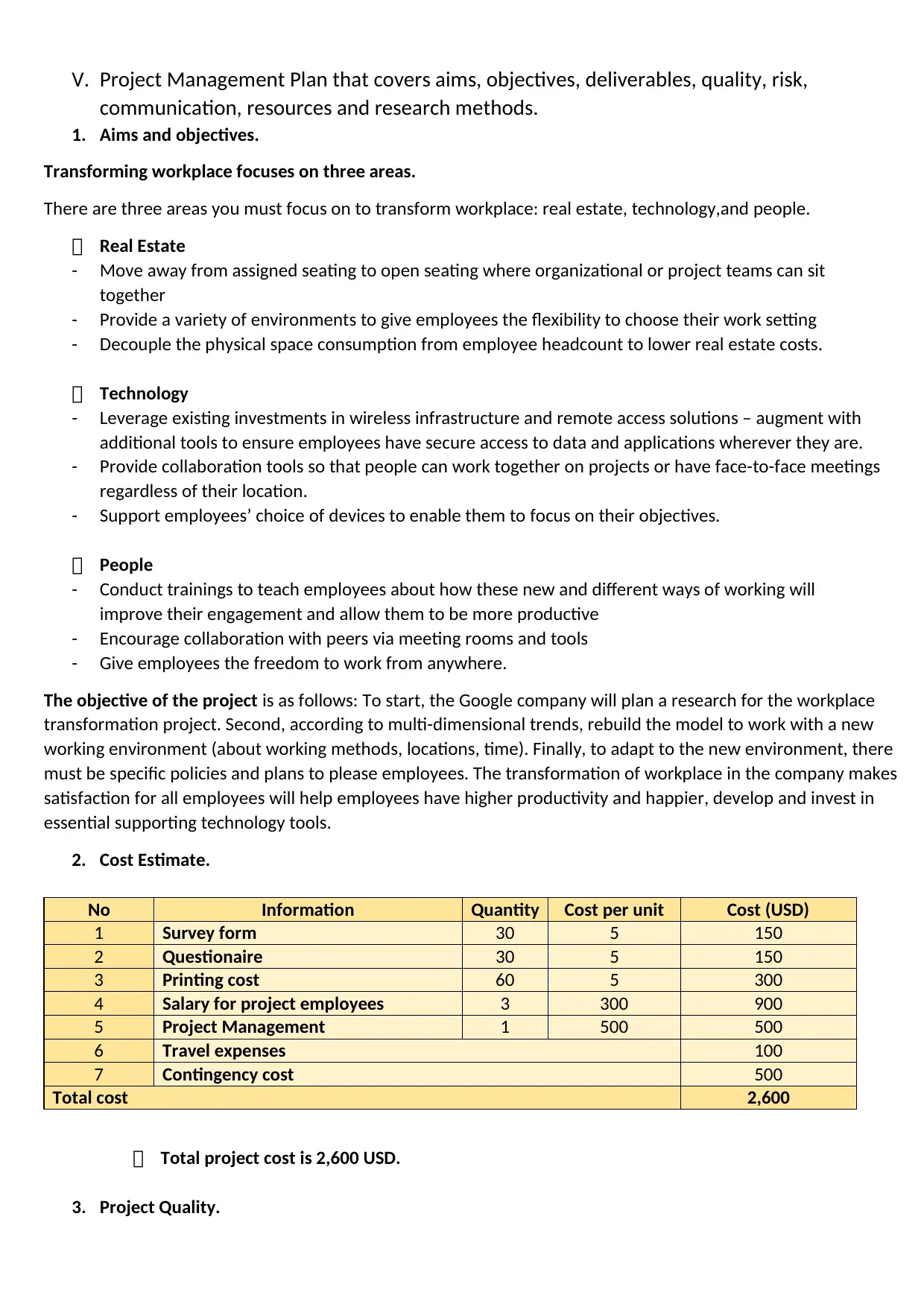
V. Project Management Plan that covers aims, objectives, deliverables, quality, risk,
communication, resources and research methods.
1. Aims and objectives.
Transforming workplace focuses on three areas.
There are three areas you must focus on to transform workplace: real estate, technology,and people.
Real Estate
- Move away from assigned seating to open seating where organizational or project teams can sit
together
- Provide a variety of environments to give employees the flexibility to choose their work setting
- Decouple the physical space consumption from employee headcount to lower real estate costs.
Technology
- Leverage existing investments in wireless infrastructure and remote access solutions – augment with
additional tools to ensure employees have secure access to data and applications wherever they are.
- Provide collaboration tools so that people can work together on projects or have face-to-face meetings
regardless of their location.
- Support employees’ choice of devices to enable them to focus on their objectives.
People
- Conduct trainings to teach employees about how these new and different ways of working will
improve their engagement and allow them to be more productive
- Encourage collaboration with peers via meeting rooms and tools
- Give employees the freedom to work from anywhere.
The objective of the project is as follows: To start, the Google company will plan a research for the workplace
transformation project. Second, according to multi-dimensional trends, rebuild the model to work with a new
working environment (about working methods, locations, time). Finally, to adapt to the new environment, there
must be specific policies and plans to please employees. The transformation of workplace in the company makes
satisfaction for all employees will help employees have higher productivity and happier, develop and invest in
essential supporting technology tools.
2. Cost Estimate.
No Information Quantity Cost per unit Cost (USD)
1 Survey form 30 5 150
2 Questionaire 30 5 150
3 Printing cost 60 5 300
4 Salary for project employees 3 300 900
5 Project Management 1 500 500
6 Travel expenses 100
7 Contingency cost 500
Total cost 2,600
Total project cost is 2,600 USD.
3. Project Quality.
communication, resources and research methods.
1. Aims and objectives.
Transforming workplace focuses on three areas.
There are three areas you must focus on to transform workplace: real estate, technology,and people.
Real Estate
- Move away from assigned seating to open seating where organizational or project teams can sit
together
- Provide a variety of environments to give employees the flexibility to choose their work setting
- Decouple the physical space consumption from employee headcount to lower real estate costs.
Technology
- Leverage existing investments in wireless infrastructure and remote access solutions – augment with
additional tools to ensure employees have secure access to data and applications wherever they are.
- Provide collaboration tools so that people can work together on projects or have face-to-face meetings
regardless of their location.
- Support employees’ choice of devices to enable them to focus on their objectives.
People
- Conduct trainings to teach employees about how these new and different ways of working will
improve their engagement and allow them to be more productive
- Encourage collaboration with peers via meeting rooms and tools
- Give employees the freedom to work from anywhere.
The objective of the project is as follows: To start, the Google company will plan a research for the workplace
transformation project. Second, according to multi-dimensional trends, rebuild the model to work with a new
working environment (about working methods, locations, time). Finally, to adapt to the new environment, there
must be specific policies and plans to please employees. The transformation of workplace in the company makes
satisfaction for all employees will help employees have higher productivity and happier, develop and invest in
essential supporting technology tools.
2. Cost Estimate.
No Information Quantity Cost per unit Cost (USD)
1 Survey form 30 5 150
2 Questionaire 30 5 150
3 Printing cost 60 5 300
4 Salary for project employees 3 300 900
5 Project Management 1 500 500
6 Travel expenses 100
7 Contingency cost 500
Total cost 2,600
Total project cost is 2,600 USD.
3. Project Quality.
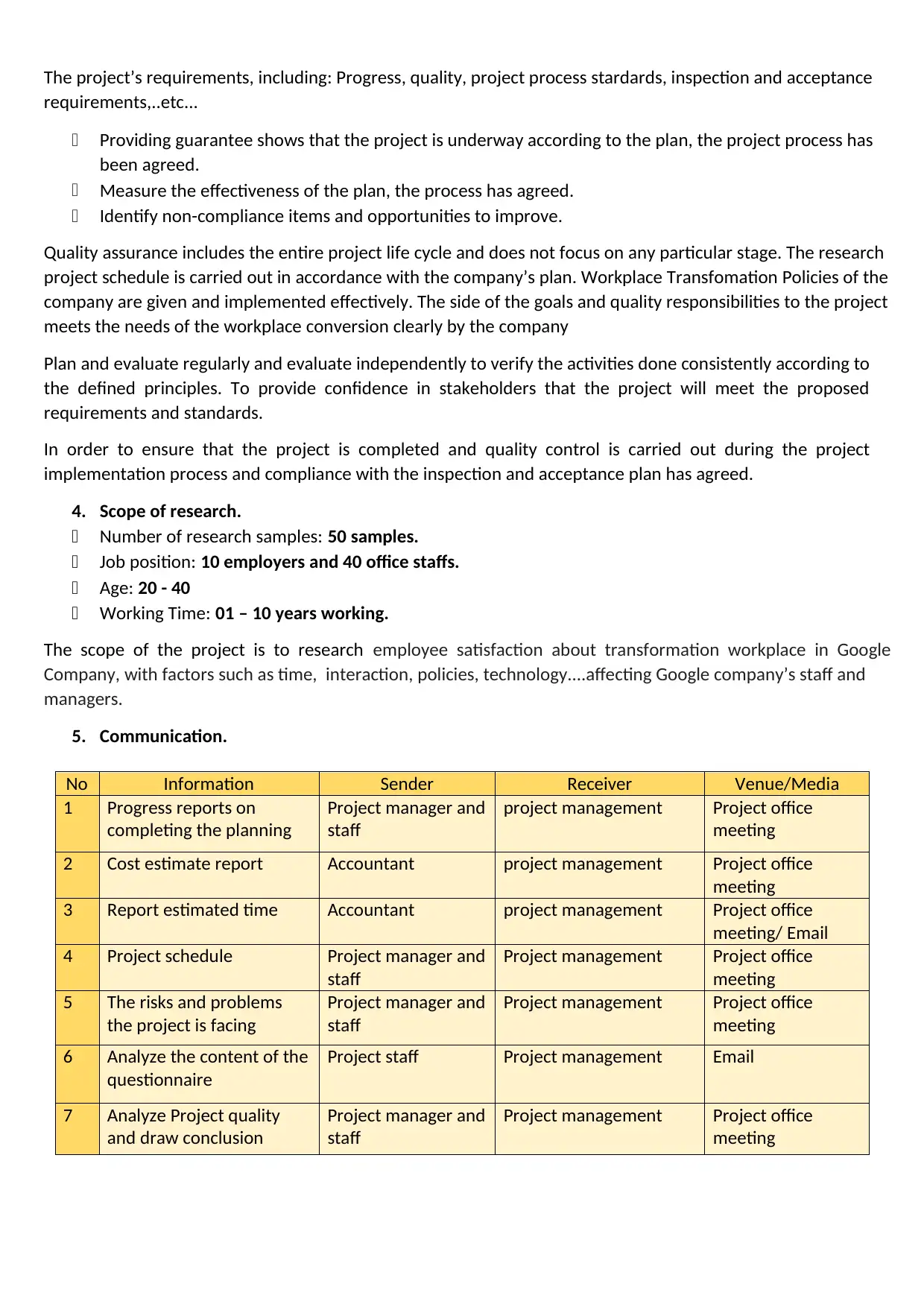
The project’s requirements, including: Progress, quality, project process stardards, inspection and acceptance
requirements,..etc...
Providing guarantee shows that the project is underway according to the plan, the project process has
been agreed.
Measure the effectiveness of the plan, the process has agreed.
Identify non-compliance items and opportunities to improve.
Quality assurance includes the entire project life cycle and does not focus on any particular stage. The research
project schedule is carried out in accordance with the company’s plan. Workplace Transfomation Policies of the
company are given and implemented effectively. The side of the goals and quality responsibilities to the project
meets the needs of the workplace conversion clearly by the company
Plan and evaluate regularly and evaluate independently to verify the activities done consistently according to
the defined principles. To provide confidence in stakeholders that the project will meet the proposed
requirements and standards.
In order to ensure that the project is completed and quality control is carried out during the project
implementation process and compliance with the inspection and acceptance plan has agreed.
4. Scope of research.
Number of research samples: 50 samples.
Job position: 10 employers and 40 office staffs.
Age: 20 - 40
Working Time: 01 – 10 years working.
The scope of the project is to research employee satisfaction about transformation workplace in Google
Company, with factors such as time, interaction, policies, technology....affecting Google company’s staff and
managers.
5. Communication.
No Information Sender Receiver Venue/Media
1 Progress reports on
completing the planning
Project manager and
staff
project management Project office
meeting
2 Cost estimate report Accountant project management Project office
meeting
3 Report estimated time Accountant project management Project office
meeting/ Email
4 Project schedule Project manager and
staff
Project management Project office
meeting
5 The risks and problems
the project is facing
Project manager and
staff
Project management Project office
meeting
6 Analyze the content of the
questionnaire
Project staff Project management Email
7 Analyze Project quality
and draw conclusion
Project manager and
staff
Project management Project office
meeting
requirements,..etc...
Providing guarantee shows that the project is underway according to the plan, the project process has
been agreed.
Measure the effectiveness of the plan, the process has agreed.
Identify non-compliance items and opportunities to improve.
Quality assurance includes the entire project life cycle and does not focus on any particular stage. The research
project schedule is carried out in accordance with the company’s plan. Workplace Transfomation Policies of the
company are given and implemented effectively. The side of the goals and quality responsibilities to the project
meets the needs of the workplace conversion clearly by the company
Plan and evaluate regularly and evaluate independently to verify the activities done consistently according to
the defined principles. To provide confidence in stakeholders that the project will meet the proposed
requirements and standards.
In order to ensure that the project is completed and quality control is carried out during the project
implementation process and compliance with the inspection and acceptance plan has agreed.
4. Scope of research.
Number of research samples: 50 samples.
Job position: 10 employers and 40 office staffs.
Age: 20 - 40
Working Time: 01 – 10 years working.
The scope of the project is to research employee satisfaction about transformation workplace in Google
Company, with factors such as time, interaction, policies, technology....affecting Google company’s staff and
managers.
5. Communication.
No Information Sender Receiver Venue/Media
1 Progress reports on
completing the planning
Project manager and
staff
project management Project office
meeting
2 Cost estimate report Accountant project management Project office
meeting
3 Report estimated time Accountant project management Project office
meeting/ Email
4 Project schedule Project manager and
staff
Project management Project office
meeting
5 The risks and problems
the project is facing
Project manager and
staff
Project management Project office
meeting
6 Analyze the content of the
questionnaire
Project staff Project management Email
7 Analyze Project quality
and draw conclusion
Project manager and
staff
Project management Project office
meeting
⊘ This is a preview!⊘
Do you want full access?
Subscribe today to unlock all pages.

Trusted by 1+ million students worldwide
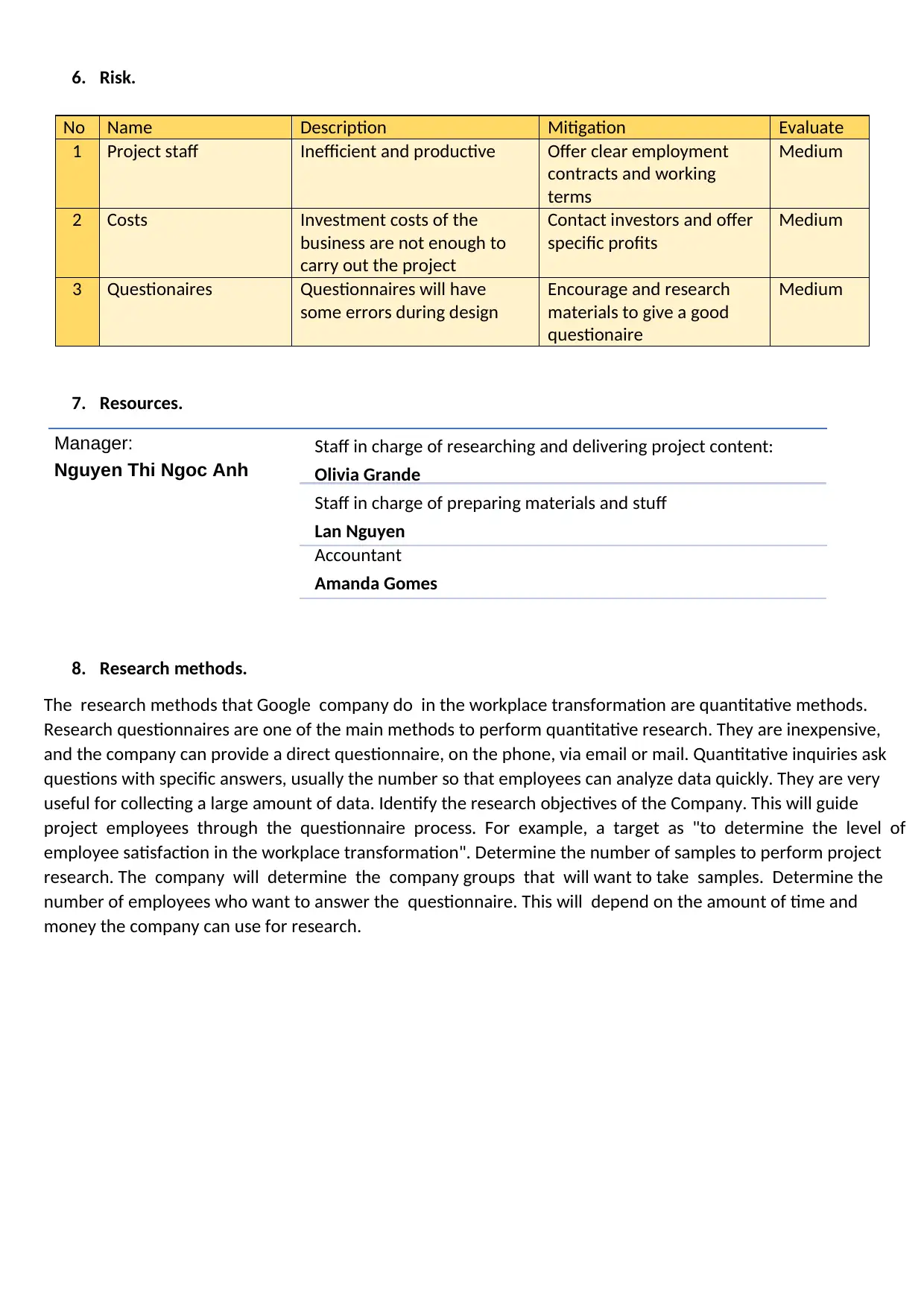
6. Risk.
No Name Description Mitigation Evaluate
1 Project staff Inefficient and productive Offer clear employment
contracts and working
terms
Medium
2 Costs Investment costs of the
business are not enough to
carry out the project
Contact investors and offer
specific profits
Medium
3 Questionaires Questionnaires will have
some errors during design
Encourage and research
materials to give a good
questionaire
Medium
7. Resources.
8. Research methods.
The research methods that Google company do in the workplace transformation are quantitative methods.
Research questionnaires are one of the main methods to perform quantitative research. They are inexpensive,
and the company can provide a direct questionnaire, on the phone, via email or mail. Quantitative inquiries ask
questions with specific answers, usually the number so that employees can analyze data quickly. They are very
useful for collecting a large amount of data. Identify the research objectives of the Company. This will guide
project employees through the questionnaire process. For example, a target as "to determine the level of
employee satisfaction in the workplace transformation". Determine the number of samples to perform project
research. The company will determine the company groups that will want to take samples. Determine the
number of employees who want to answer the questionnaire. This will depend on the amount of time and
money the company can use for research.
Manager:
Nguyen Thi Ngoc Anh
Staff in charge of researching and delivering project content:
Olivia Grande
Staff in charge of preparing materials and stuff
Lan Nguyen
Accountant
Amanda Gomes
No Name Description Mitigation Evaluate
1 Project staff Inefficient and productive Offer clear employment
contracts and working
terms
Medium
2 Costs Investment costs of the
business are not enough to
carry out the project
Contact investors and offer
specific profits
Medium
3 Questionaires Questionnaires will have
some errors during design
Encourage and research
materials to give a good
questionaire
Medium
7. Resources.
8. Research methods.
The research methods that Google company do in the workplace transformation are quantitative methods.
Research questionnaires are one of the main methods to perform quantitative research. They are inexpensive,
and the company can provide a direct questionnaire, on the phone, via email or mail. Quantitative inquiries ask
questions with specific answers, usually the number so that employees can analyze data quickly. They are very
useful for collecting a large amount of data. Identify the research objectives of the Company. This will guide
project employees through the questionnaire process. For example, a target as "to determine the level of
employee satisfaction in the workplace transformation". Determine the number of samples to perform project
research. The company will determine the company groups that will want to take samples. Determine the
number of employees who want to answer the questionnaire. This will depend on the amount of time and
money the company can use for research.
Manager:
Nguyen Thi Ngoc Anh
Staff in charge of researching and delivering project content:
Olivia Grande
Staff in charge of preparing materials and stuff
Lan Nguyen
Accountant
Amanda Gomes
Paraphrase This Document
Need a fresh take? Get an instant paraphrase of this document with our AI Paraphraser
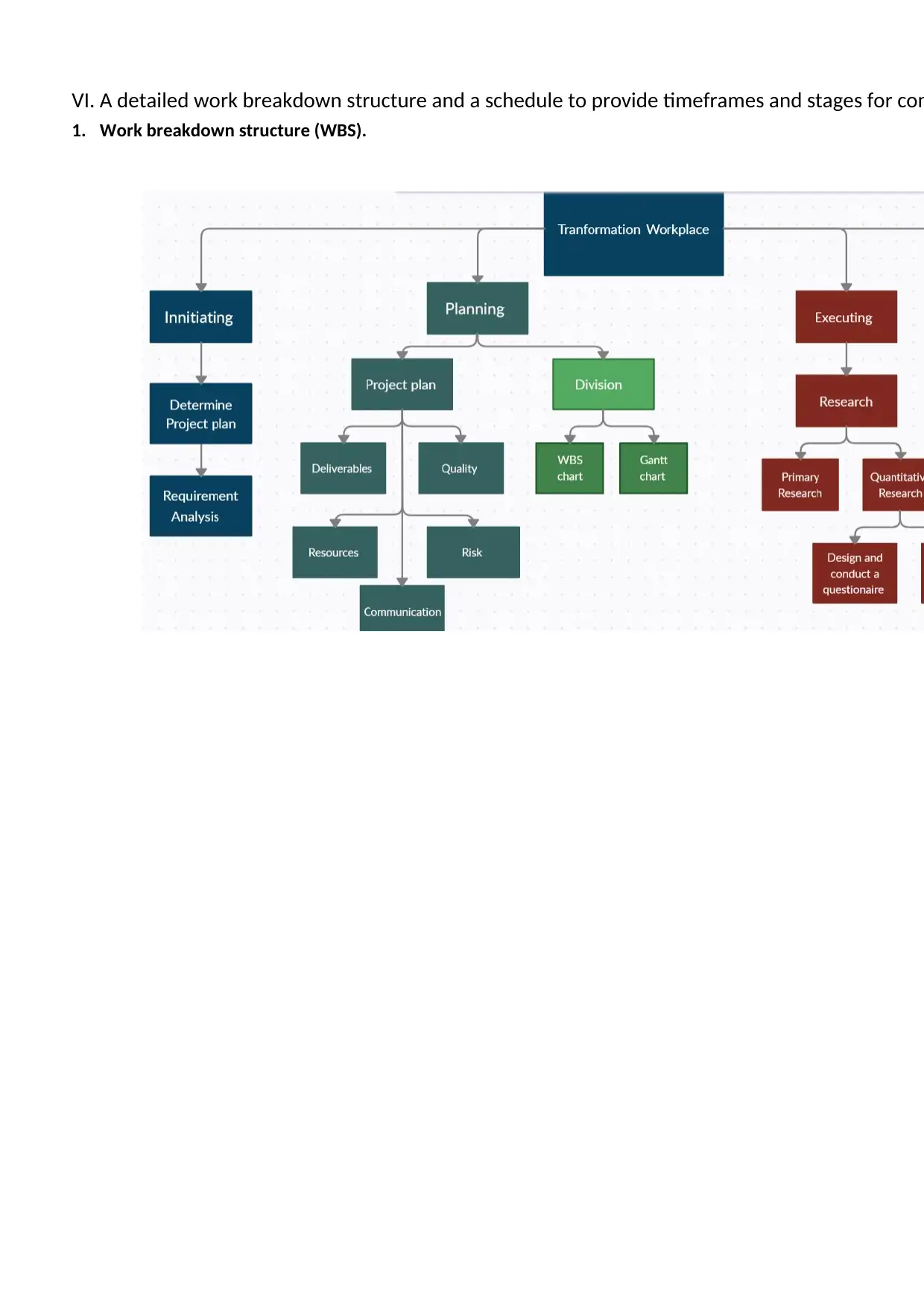
VI. A detailed work breakdown structure and a schedule to provide timeframes and stages for com
1. Work breakdown structure (WBS).
1. Work breakdown structure (WBS).
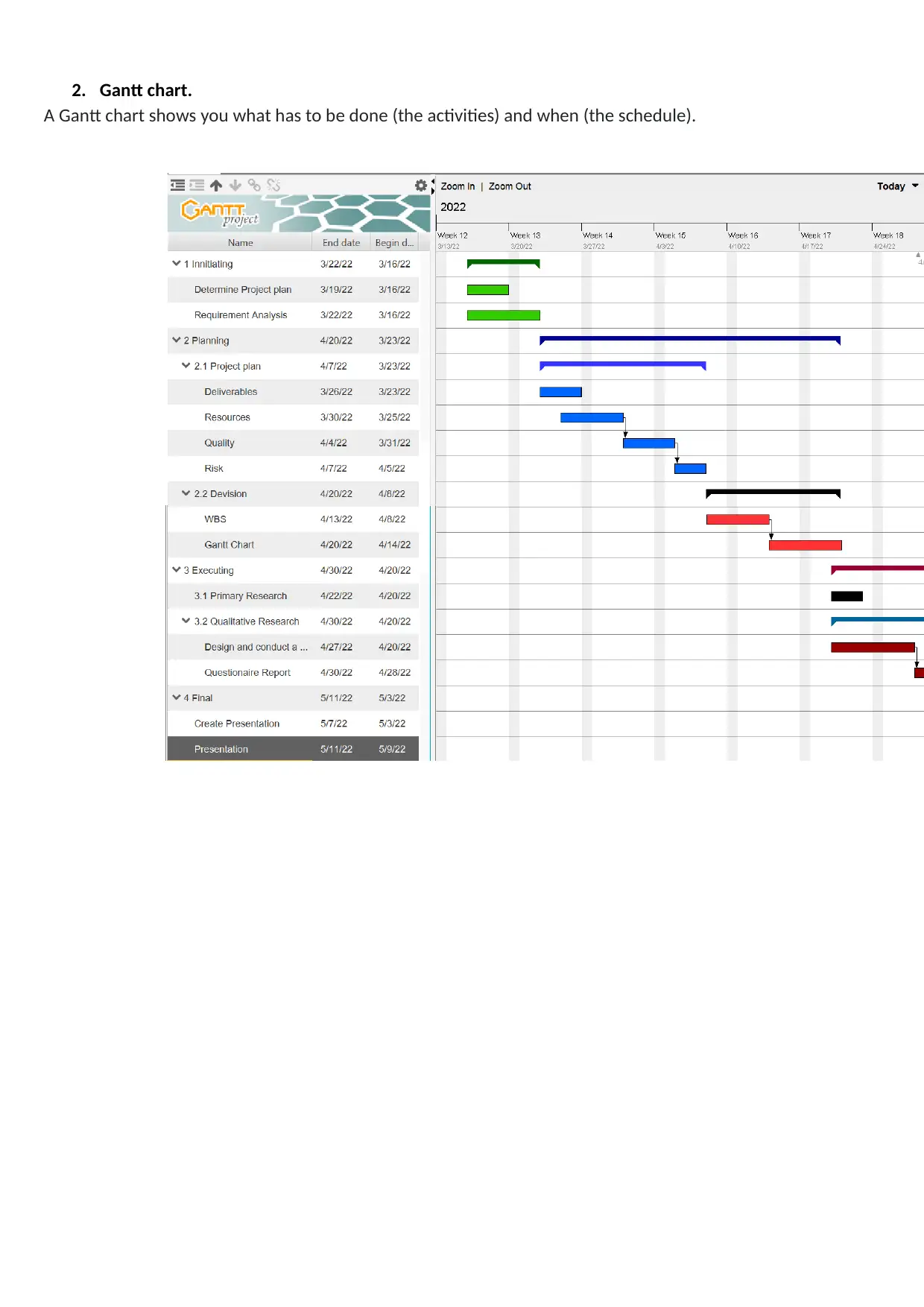
2. Gantt chart.
A Gantt chart shows you what has to be done (the activities) and when (the schedule).
A Gantt chart shows you what has to be done (the activities) and when (the schedule).
⊘ This is a preview!⊘
Do you want full access?
Subscribe today to unlock all pages.

Trusted by 1+ million students worldwide
1 out of 24
Related Documents
Your All-in-One AI-Powered Toolkit for Academic Success.
+13062052269
info@desklib.com
Available 24*7 on WhatsApp / Email
![[object Object]](/_next/static/media/star-bottom.7253800d.svg)
Unlock your academic potential
Copyright © 2020–2025 A2Z Services. All Rights Reserved. Developed and managed by ZUCOL.





